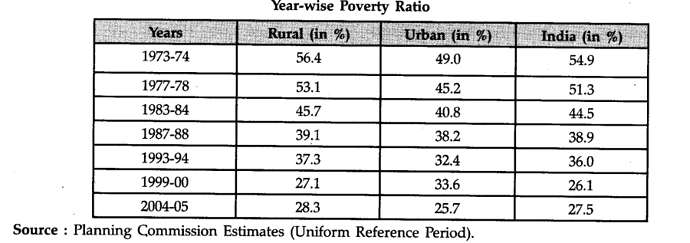Illustrate the difference between rural and urban poverty. Is it correct to say that poverty has shifted from rural to urban areas? Use the trends in poverty ratio to support your answer.
or
Discuss poverty estimates since 1973-74 for country as a whole and draw out salient trends for rural areas and urban areas.
The difference between rural and urban poverty is mainly of the nature of poverty. The poor are identified on the basis of their occupation and ownership of assets. The rural poor work mainly as landless agricultural labourers, cultivators with very small land holdings, landless labourers who are engaged in a variety of non-agricultural jobs and tenant cultivators with small land holdings. On the other hand, the urban poor are largely the overflow of the rural poor who had migrated to urban areas in search of alternative employment and livehmood, labourers who do a variety of casual jobs and the self-employed who sell a va-riety of things on roadsides and are engaged in various activities. It can be seen from the given table showing the trends in poverty ratio which has shifted from rural to urban areas.
It is evident from the above table that rural poverty has declined significantly from 56.4% in 1973-74 to 28.3% in 2004-05 whereas, decline in urban poverty (from 49% to 25.7%) is not thai significant. Moreover, the gap between the rural and urban poverty ratios which was around 7% in 1973-74 fell to just around 2% in 2004-05 again signifying the shift in poverty from rural to urban areas. There are many factors other than income and as-sets which are associated with poverty, for instance, the accessibility to basic education, health care, drinking water and sanitation have been ignored. The mechanism for determining poverty line also does not take into consideration social factors that trigger and perpetuate poverty such as illiteracy, ill health, lack of access to resources discrimination or lack of civil and political freedom.
